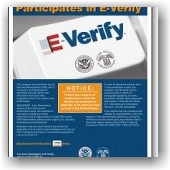Ketchikan Drywall Services (KDS), a drywall and framing company in Washington, was found to have committed 225 separate I-9 violations for which they were fined $173,250 ($770/each) discovered during an ICE I-9 audit.
ICE subpoenaed employees’ I-9s and supporting documentation dating back 3+ years. KDS initially provided approximately 454 I-9 forms with ‘some’ supporting documentation. More than a year later, KDS provided another 81 I-9 forms, totaling 535.
ICE issued a NOI (Notice of Intent) to fine 271 I-9 form violations for a fine of $286,000. KDS disputed the fine, the case went before OCAHO (Office of the Chief Administrative Law Hearing Officer) who rigidly found no reason at the time to reduce the fine.
With over 250 violations, there were obviously a number of issues, such as:
1) Were employees recalled from layoff or rehired? The company hired a lot of seasonal employees. If you are recalling from layoff, there is no need for a new I-9 form. If you’re rehiring, then Section 3 needs to be filled out (if rehired within 3 years), or a new I-9 form.
2) Whether supporting documentation was sufficient when the I-9 has none of the information filled out in Section 2? The Administrative Law Judge stated that the supporting documentation could only be reviewed if there was human error in transcribing information onto the I-9 form.
3) Whether late production of a permanent resident card alleviates a substantive violation for no status box being checked when the Section 1 was originally filled out; and whether certain recorded information in Section 1 can alleviate a substantive violation for failing to check a status box or more than one status box? There were a number of issues with employees who failed to check a status box for citizen, permanent resident, or authorized to work or who failed to write in any information. The fact that the employer later presented LPR cards, was of no value – it was still considered a substantive violation. If the citizen box was checked with permanent resident or authorized to work, it was considered a substantive violation because the checked boxes are contrary to each other.
There were a number of other violations such as:
4) Failure to sign the form
5) Failure to list any or all the necessary information in List A, B or C
6) Acceptance of improper documentation
Overall, there were 271 I-9 forms with substantive violations out of 535 presented I-9s – 50% of the I-9s, $110 to $935 per violation. They got hit with a fine at the top of the range, $935. ICE indicated that they could be fined $286K.
In the end, the ALJ (Administrative Law Judge) found that ICE proved 225 substantive violations in the 535 I-9 forms for a 42% violation rate, which equated to a base fine of $770 per I-9, or $173,250.
This case represents a prime example of what we see in our I-9 audit practice whether you have a diverse workforce or not, clerical errors and oversights play a huge part in the process and they equate to technical and substantive errors – an exceedingly expensive outcome for something that can be averted with the development of a compliance program that works for your business, with regular audits and training.
We link to the Final Decision and Order
Check out our group on LinkedIn, I-9 Smart Solutions for Employers.





